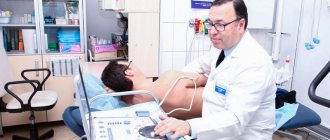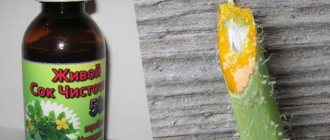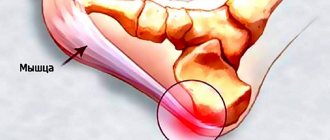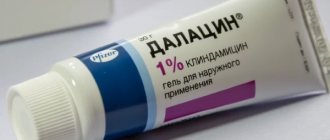Causes of low stomach acidity
The stomach responds to almost any irritant by increasing the concentration of hydrochloric acid. But under the influence of some reasons the reverse process occurs. Most often, these are reasons that inhibit the activity of the human nervous system, for example, stress. A simple example: if you eat a sandwich in a state of haste or excitement, a heaviness in the stomach is inevitably guaranteed. In healthy people, the feeling of heaviness quickly passes. But if such sensations are repeated outside of stress, and at the same time other symptoms of “indigestion” appear, then this is probably a disease.
Low acidity is one of the symptoms of a number of diseases and pathological conditions. Here is their list:
- Chronic gastritis. In the first phase of its development, the disease is accompanied by increased secretory activity of the glands of the gastric mucosa, as a response to its inflammation. Subsequently, atrophy of the mucosa occurs and the number of glands producing hydrochloric acid decreases. And this is gastritis with low acidity. The disease progresses slowly, and low gastric acidity is more common in older people.
- Diseases of the endocrine glands: thyroiditis (pathology of the thyroid gland), diabetes mellitus (pathology of the pancreas), Addison's disease and some others.
- Oncological diseases.
- Anemia. An insufficient amount of hydrochloric acid is associated with malabsorption and deficiency of iron and vitamin B12, therefore, with anemia.
- Alopecia areata.
- Vitiligo.
- Taking antacids
- Parasitic infections.
- Autoimmune gastritis.
- Alcoholism.
In this case, hydrochloric acid in the stomach performs several functions:
- activates the secretory activity of the digestive glands of the stomach;
- creates conditions (acidity of a certain level) for the work of enzymes that break down protein;
- causes denaturation of proteins (this also contributes to their breakdown by enzymes);
- antibacterial function (therefore the stomach is a serious barrier to infection);
- in addition, as an irritant, hydrochloric acid activates the receptors of the mucous membrane of the junction of the stomach and the duodenum, thereby participating in the mechanism of passage of food from the stomach to the small intestine,
- hydrochloric acid performs a regulatory hormonal function (regulates the function of the glands that produce secretin and gastrin);
- stimulates gastric motility (contraction of the stomach walls)
- hydrochloric acid curdles milk (denatures milk proteins).
Kinds
Hydrochloric acid in the stomach not only contributes to the proper digestive process. It also destroys pathogenic bacteria and microorganisms that enter the stomach.
In medicine, the following types of acidity levels are distinguished:
| Name | Description |
| Basal | The level of hydrochloric acid in the stomach, which can be determined on an empty stomach. With low acidity, the values fluctuate between 2.1-6.0. |
| Stimulated | Hydrochloric acid, which is produced after a trial breakfast or while taking certain medications. As a result of low acidity, the values are in the range of 2.1-3.0. |
There are certain norms for stomach acidity, taking into account its type:
| Name | Standards (pH) |
| On empty stomach | 1,5-2 |
| Minimum | 0,86 |
| Maximum | 8,3 |
| In the antal area | 1,3-7,4 |
| In epithelial tissues | 7,0 |
Diagnosis and treatment is carried out by a gastroenterologist. The specialist, taking into account the patient’s condition, prescribes informative examination methods to make an accurate diagnosis.
Determination of acidity
To determine the level of hydrochloric acid in gastric juice, there are several methods today, including:
- The method of intragastric pH-metry, which is the most physiological and reliable. Acidity is determined directly in various areas of the gastrointestinal tract using special devices with pH sensors and probes - acidogastrometers. Depending on the diagnostic task, acidity is determined:
- express, in which indicators are assessed within 20 minutes;
- short-term – in a few hours;
- daily – 24 hours;
- endoscopic – during endoscopy.
- An aspiration method that allows sampling of stomach contents using a fractional probe that sucks gastric secretions from the intestines and stomach. During the diagnostic process, gastric contents from different zones are mixed, which distorts the result, making it approximate.
Medicines
Drug treatment is prescribed for serious disorders of the gastrointestinal tract along with diet and physiotherapy.
Usually prescribed medications:
- painkillers;
- antispasmodics to stimulate the secretion of gastric juice: Prozerin, Cerucal, Etimizol;
- folic acid;
- hydrochloric acid inhibitors;
- anticholinergics;
- antibiotics to suppress infections;
- antacids to eliminate excess acid.
Drug therapy helps restore affected areas of the gastrointestinal mucosa, secretion functions and support a weakened body.
Signs and symptoms
A decrease in the acidity of digestive juice is quite difficult to determine. This disease does not have pronounced symptoms, so it is better to consult a doctor if the following appears after eating:
- belching with a rotten smell;
- bad breath;
- bowel dysfunction, especially constipation;
- nausea with vomiting;
- when undigested food is visible in the stool;
- sharp cramping pain in the stomach;
- lack of appetite;
- bloating and accumulation of gases in the abdomen.
A decrease in acidity in the organ leads to serious disruptions in the functioning of the entire gastrointestinal tract, so you need to get tested to avoid minor deviations turning into a chronic disease.
With such secretion of digestive juice, the following occurs:
- slow digestibility of proteins, which leads to the accumulation of breakdown products in the body and its intoxication;
- decreased immunity, and as a result, the development of viral and fungal diseases;
- when the organ processes food poorly, the human body does not receive enough vitamins and minerals, which affects the condition of nails and hair;
- the skin becomes dry and painful in appearance, acne forms on it or inflammatory processes appear;
- with an advanced decrease in acidity, the patient develops an allergy;
- Sleep is disturbed, the person becomes lethargic and may become depressed.
These diseases can be avoided by returning the digestive juice to its normal acidity. The reason for the decrease in acidity is:
- malfunction of the fundic gland, in which parietal cells are not produced; the saturation of hydrochloric acid depends on their number;
- improper and irregular nutrition;
- prolonged stress and taking antidepressants;
- some diuretics, bronchodilators and antibiotics cause a decrease in acidity.
It is enough to adjust the diet, restore the disturbed microflora, and the stomach will work as expected again, but before that the doctor must determine how low the acidity is.
General information
Statistics show that gastritis with low acidity accounts for approximately a quarter of all cases of gastritis with which patients consult doctors. If an inflammatory process of the gastric mucosa is discovered for the first time during fibrogastroduodenoscopy in a person, then, as a rule, he is diagnosed with “superficial gastritis with high acidity .”
And when the acute inflammatory process becomes chronic, then high acidity levels remain for a long time. But if chronic gastritis progresses over the years, then in approximately 60% of cases there is a decrease in acidity values. In this case, signs of low stomach acidity appear. That is why this condition is more typical for older people.
Diagnostics
In addition to standard medical history procedures, a number of laboratory tests of gastric juice are performed. Diagnosis in modern medical practice is represented by the following set of methods:
- the degree of staining of urine makes it possible to determine the degree of acidity of gastric juice - this technique is not often used today due to its inaccuracy and ineffectiveness;
- method of gastric probing - with this method, gastric juice is collected using a special rubber probe for laboratory testing for acidity;
- pH-metric methods - they are also carried out using special probes equipped with equipment that allows diagnostics of secretion within the stomach without collecting juice for analysis. There are intragastric and esophageal pH measurements.
pH-metric methods are the most accurate and effective methods. Today they are used everywhere.
Gastric intubation is used less frequently due to the presence of a number of serious contraindications. Thus, it is not recommended to carry out probing:
- during pregnancy;
- risks or presence of stomach bleeding;
- for diabetes mellitus, kidney, pulmonary failure, vascular and heart diseases due to the drugs used during the procedure, such as insulin or histamine.
In addition, the intubation procedure can lead to injury to the stomach or cause problems with its functioning.
How to treat low stomach acidity?
For low gastric acidity, the main treatment in adults is aimed at eliminating 3 main problems that slow down the production of HCl and lead to complications:
- restoring the functioning of the glands, stimulating them to active functioning;
- elimination of any diseases of the gastrointestinal tract;
- destruction of pathogenic bacterial flora.
Therapy is complex. Doctors put dietary nutrition first, followed immediately by taking medications, and to support the achieved result, you can turn to traditional medicine recipes.
Medications
In case of reduced stomach acidity, a complex of medications is used that affect the functioning of the gastrointestinal tract, envelop the digestive organs from the inside, protecting them, and also facilitate the process of breaking down food:
- antibacterial agents – kill intestinal flora, which helps protect the body from bacterial infections;
- probiotics – prescribed simultaneously with antibiotics, they populate the gastrointestinal tract with beneficial bacteria, leaving no room for pathogens;
- antispasmodics – relieve intestinal spasms, stabilize its motility;
- enveloping agents - line the stomach from the inside, protecting the delicate mucous membrane from negative influences;
- vitamins – strengthen the body, eliminate symptoms of anemia;
- Enzymatic preparations - help the stomach break down food.
Medicines must be taken strictly as prescribed by the attending physician, since the dosage and medications must be selected individually, otherwise they can only cause harm to the body.
Folk remedies
Traditional medicine also gives good results in the fight against low acidity. Treatment is carried out using juice remedies, such as infusions of chokeberry, lingonberry, rose hips, viburnum, aloe, calamus, fennel, and anise.
Effectively increase the level of acidity in the stomach:
- honey water (100 grams of warm water with a teaspoon of honey diluted in it), which should be taken half an hour before meals;
- alcohol tincture of unripe walnut fruits, prepared from 15 green nuts infused for 2 weeks in half a liter of vodka;
- natural gooseberries.
A reduced level of stomach acidity is a symptom of a disease with metabolic disorders in the body, and its treatment will be effective after the elimination of the underlying disease, followed by correction of digestive problems using replacement therapy drugs, diet and herbal teas.
Treatment of low acidity levels is a fairly lengthy process that requires patience, endurance and strict adherence to all recommendations and prescriptions of the attending physician.
Nutrition and diet rules
For patients suffering from low acidity of gastric juice, it is important to follow a therapeutic diet during the course of therapy. When the disease worsens, food restrictions are strict; when the patient’s well-being improves, a gradual expansion of the diet is allowed.
The basis of dietary nutrition is protein foods and foods enriched with vitamins, microelements and minerals.
Dietary recommendations for low acidity:
- It is recommended to use soups made from thoroughly pureed vegetables. Preference is given to potatoes, carrots and cabbage.
- Lean parts of rabbit, chicken and turkey are steamed.
- Fish (hake, river perch, pollock, cod) can be baked or boiled.
- Cheeses are only allowed to be consumed in mild, low-fat varieties (brynza, Adyghe, Russian).
- Fried or hard-boiled eggs should be replaced with omelets or soft-boiled eggs.
- Cereals (oats, rice, wheat, buckwheat) are consumed in the form of boiled porridge and without butter; it is permissible to add a small piece only to oatmeal.
- Vegetables and fruits can be eaten raw, boiled or baked. The choice should be made of potatoes, pumpkin, carrots, apricots, bananas and pears.
After the patient’s well-being improves and acute symptoms of the disease are relieved, the doctor recommends including foods that can normalize the acid balance:
- Yogurts and other fermented milk drinks with a high percentage of fat content, but without additives.
- Natural juices from carrots, apples, oranges.
- Fresh fruits: quince, grapes, citrus fruits, pomegranate.
- Vegetables: cucumbers, tomatoes, cabbage.
- Berries: lingonberries, cranberries, currants, cherries.
Coffee is allowed to be drunk in limited quantities and not hot. To enrich with vitamins, it is recommended to consume honey and fruit jellies or marmalade, which are based on natural juices.
Folk remedies
How to increase stomach acidity using folk remedies. Herbal teas and infusions, which are also recommended by doctors, help normalize the functioning of the gastrointestinal tract.
Products containing wormwood and other herbs are extremely effective:
- Wormwood infusion: 2 tbsp. l of flowers leave for 3 hours in ½ l of boiling water and drink ¼ tbsp. 30 minutes before meals.
- Herbal infusion: mix 1 teaspoon each of wormwood, mint, sage, chamomile and yarrow flowers. Then pour 2 teaspoons of the mixture into a glass of boiling water and leave. Drink the strained mixture 30 minutes before meals.
- Infusion of elecampane: 1 s. l herbs pour 1 tbsp. boiling water and simmer for 30 minutes. Drink 1 tbsp. l before meals.
- Viburnum decoction: pour 200 grams of berries with 1.5 tbsp. water and boil. Leave for 1 hour, strain and drink 2 tbsp. l after meals.
- Drink ¼ tbsp blackcurrant juice. after meal.
- Eat 1 teaspoon of grated horseradish and honey before meals.
Treatment of low acidity
Treatment with traditional methods is carried out along with diet and only after consultation with your doctor.
What is needed for prevention?
For the purpose of prevention, you need to eliminate or minimize as much as possible the presence of factors in your life that negatively affect the functioning of the gastrointestinal tract and irritate its mucous membrane:
- avoid drinking alcohol and smoking;
- stop being nervous;
- start eating right;
- promptly identify and treat various diseases, especially the digestive system;
- Take medications only as recommended by a doctor, do not self-medicate.
In addition, you need to periodically visit a doctor for a preventive examination. This will help catch the disease at the very beginning and get rid of it quickly.
Gastritis Stomach ulcer Gastroduodenitis Stomach cancer Duodeno-gastric reflux Reflux esophagitis











